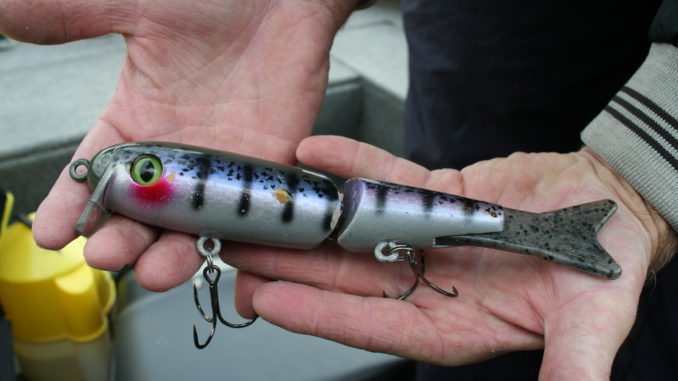
The 11-pound, 2-ounce largemouth that Rob McComas caught in November 2008 fell for a big swimbait, a lure he believes is key to landing trophy bass in Lake Jocassee.
“I was fishing a spot I did not normally fish and had made a cast off the end of a tree,” he recalled. “My bait was sinking, but I had not started moving it. I made one or two turns on the reel handle, and he had it.”
Almost all of McComas’ big bass have been caught on a swimbait, a lure he first learned about in the mid-1990s.
“I read an article in a magazine, I think it was Bassmaster, about the AC Plug, the first big swimbait out in California. When I read that article about using the swimbait in a deep, clear lake, I said ‘That is Lake Jocassee,’” said McComas, who bought an AC Plug and would try it for an hour or two without success, then give up on it before one day deciding to go for broke with it.
“I determined that if it took a month, I did not care. I was going to catch a fish on a swimbait,” he said.
And the first day he really committed to the lure, he found magic.
“I caught three bass that day and missed two more. One of them was a 5-pound smallmouth that ate the tail off my bait,” he said.
Now, when McComas goes fun-fishing at Jocassee he is armed with an array of swimbaits and 20 years of experience on where to use it and how to retrieve it realistically. He casts it on big muskie rods with 30-pound monofilament line spooled on ABU-Garcia 6500 reels to sunken trees, logs, rock outcroppings and steep banks that he knows are frequented by big largemouths.
The adage that 90 percent of the fish live in 10 percent of the water is especially true at Jocassee, McComas said.
“There are miles and miles of good-looking rocks, trees and stumps, and a lot of them don’t hold any fish,” he said. “You have to put in the time to learn the spots that produce.”
When he fishes for smallmouth, McComas goes in the other direction, working a 1/8- or 1/16-ounce floating fly jig on 4-pound-test line with a 9-foot noodle rod. He has worked the fly for smallmouth bass up to 4 pounds.
“It is more of a dead-of-winter tactic, and you tend to catch small fish with it, but you are also very apt to catch a big fish, too,” McComas said. “My two biggest spotted bass — 5 pounds, 8 ounces, and 5 pounds, 5 ounces — came on a floating fly, and I’ve caught largemouths up to 7 1/2 pounds on it.”
McComas said he works a small hair jig or shad-type bait from 8 to 20 feet below a bobber along steep, bluff banks.
“You have to kind of jiggle the rod, which makes that hair jig quiver as you slowly move it toward you,” he said. “The fish are lethargic in the cold water, and a lot of times they will come up and eat that little bait when they won’t chase something else.”
Finally, when McComas has a guide party that wants to spend the day catching fish, he stops at the bait store and gets plenty of minnows to fish on drop-shot rigs with spinning gear and light line. Bounced along the bottom, the live minnows are readily taken by smaller fish — mostly small spotted bass and spotted bass/redeye hybrids.

Be the first to comment